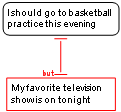The Science Of Scientific Writing Set 2 Set 2 - Indicator words : 3 types of Indicators : Example : Exercise 1 : Exercise 2 : Exercise 3 : Exercise 4 : Exercise 5 : Exercise 6-Quiz : Exercise 7 : Final page Set 2.
OVERVIEW: The way to well-written science
PART I: Paragraphs and Sentences
SET A: Paragraphs: The Maps Behind Them
SET B: Paragraphs: Using Maps to Meet Readers' Expectations
SET C: Paragraphs with Something Extra: Points and Tails
SET D: The Generic Section: Expectations and Maps as Blueprints
SET E: Scientific Sections: The Methods and Results
SET F: Scientific Sections: The Discussion
SET G : Scientific Sections: The Introduction
SET H : Sentences
SET I : The Paper as a Whole
PART II: The Paper and its Sections
SET 1: Argument Parts
SET 2: Indicator Words
SET 4: Locating Arguments in Prose
SET 5: Rationale's Essay Planner
SET 6: Evidence in Arguments: Basis Boxes
Synthesis 1: Position-Early Paragraphs
Synthesis 2: Position-Final Paragraphs
Synthesis 3: Writing a Discussion I
Synthesis 4: Writing a Discussion II
There are three kinds of indicator words: position indicators, reason indicators, and objection indicators.
Pay attention now - there will be a quiz later!
Position indicators
A position indicator gives a clue that the group of words that follow it form a position (a claim, contention). The word 'therefore' is one position indicator.
e.g. 'Only couples have entered this room therefore there must be an even number of people in the room'
The position is the claim following 'therefore'. Some other position indicators are 'hence', 'so', 'thus', 'consequently', and 'proving'. You could replace the word 'therefore' in the example with any of these and mean the same thing.
The position indicator is our clue that the map goes like this:

'Hence', 'so', 'thus' are all position indicators used when the position follows its reason/s. Other indicators, less frequently seen, are used when the position precedes its reason/s, e.g.
'Proof of there being an even number of people in the room is that only couples have entered it'
'Conclusively, the match must be over, since the stadium lights have been switched off'
Reason indicators
Reason indicators let us know that a group of words is a reason. The word 'since' is one reason indicator.
e.g. 'My car is reliable since I bought it new three months ago'
The reason is the claim that follows 'since'. Some other reason indicators are 'because', 'as', 'for', and 'follows from'.
The reason indicator that tells us the map goes like this:

There is one very important difference between arguments in map and text form. In a map the directionality is always the same. Using the Rationale-style maps as an example, a reason (or objection) always sits BELOW the position it supports (or counters). Any further reason or objection to the original reason (now considered a position itself) will likewise sit BELOW it. No matter how many sub-arguments there are in an argument, the directionality is always the same in the whole argument or any of its sub-arguments.
Verbal or text arguments, however, are much more variable. The main position (or point) of the argument as a whole is usually found either right at the end (position-final pattern) or at/near the beginning (position-early pattern). Thus the mini-argument above can be written either as:
"My car is reliable, since I bought it new three months ago." (position-early) or
"Given that I only bought my new car three months ago, it is reliable." (position-final)
While, overall, a complex written argument will also have either a position-final or position-early pattern, the overall pattern does not force itself upon the component sub-arguments: the flow pattern can vary from one sub-argument to the next.
The consistent direction of flow within an argument map, in contrast to the potential mix of directions in a written argument, is one of the main reasons why an argument map is usually much easier to follow.
Objection indicators
Objection indicators are hints that a group of words is an objection (or a rebuttal, depending on its place in your map). The word 'but' is one objection indicator.
e.g. 'I should go to basketball practice this evening but my favorite television show is on tonight'
The objection is the claim that follows 'but'. Some other objection indicators are 'although' and 'however'.
The indicator is a hint to map the reasoning like this:

Just as for reasons, a sentence that contains both a position and an objection can either be position-final or position-early, e.g.
'I should go to basketball practice this evening but my favorite television show is on tonight' (position-early)
'Even though my favorite television show is on tonight, I should go to basketball practice this evening' (position-final)
Content of this page drawn in whole or part from the Austhink Rationale Exercises with permission from Austhink .